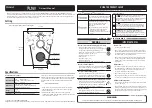
2
Operation
2.1 General
The Series 8500A Peak Power Meters are very simple to operate. You only need to follow the instructions
given in the prompts and menus shown in the display window to set up the parameters for making a
measurement. Eleven levels of operational menus are available. Each can be accessed with the MENU
key. The type of measurement (Peak or CW) being made will also be shown in the lower right corner of
the display to identify the mode in use.
Along with the menus and prompts in the display, the power meters produce audible clicks and beeps to
indicate the occurrence (or non-occurrence) of certain events during setup and testing. The tones are
defined as follows:
Click:
When a key is pressed and a click is heard, this means that the key is active and its
function will be included in the parameters being entered. If no click is heard, the
key is not active and not performing any function at that time.
Beep:
A single beep indicates that the calibration, zeroing, or self-test functions have
successfully completed when they are performed. A double beep means that the
function failed to complete. The discussion of these functions later in this chapter
will detail what problems might cause the function to fail.
There is a volume control on the rear panel of the instrument. It adjusts the audio tones to a comfortable
level, or the audio can be turned off if desired.
☛
NOTE: In the remainder of this chapter except where specified as the Model 8501A or
8502A, the instrument may be referred to as the PPM (Peak Power Meter).
2.2 Installation
The unit is set at the factory for operation at the normal supply voltage for the country in which it is
sold. The input frequency must be 50, 60, or 400 Hz
±
5%. The combination of the module and
transformer design allows instrument operation of 100/120 volts with a 2.0 A Slo-Blo fuse, or 220/240
volts with a 1.0 A Slo-Blo fuse.
WARNING
Before applying ac power to the instrument, be sure that the instrument is set for
the correct line voltage and that the fuses are of the correct rating.
Figure 2-4 illustrates the rear panel. Before operating the instrument, make sure the input voltage is
correctly set and that the fuses are compatible with the applied line voltage.
Manual No. 20790, Rev C, November 1998
2-1
Summary of Contents for 8501A
Page 12: ...Series 8500A Peak Power Meters x Manual No 20790 Rev C November 1998 ...
Page 16: ...Series 8500A Peak Power Meters xiv Manual No 20790 Rev C November 1998 ...
Page 18: ...Series 8500A Peak Power Meters xvi Manual No 20790 Rev C November 1998 ...
Page 74: ...Series 8500A Peak Power Meters 2 48 Manual No 20790 Rev C November 1998 ...
Page 156: ...Series 8500A Peak Power Meters 4 30 Manual No 20790 Rev C November 1998 ...
Page 180: ...Series 8500A Peak Power Meters 5 24 Manual No 20790 Rev C November 1998 ...
Page 230: ...Series 8500A Peak Power Meters 8 2 Manual No 20790 Rev C November 1998 ...
Page 236: ...Series 8500A Peak Power Meters A 6 Manual No 20790 Rev C November 1998 ...
Page 262: ...Series 8500A Peak Power Meters Index 8 Manual No 20790 Rev C November 1998 ...
















































